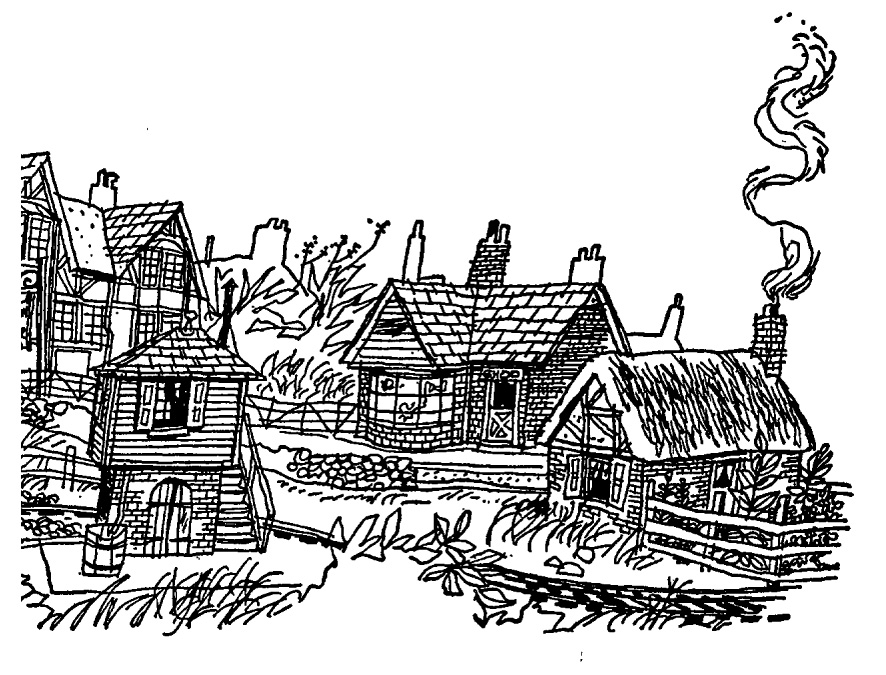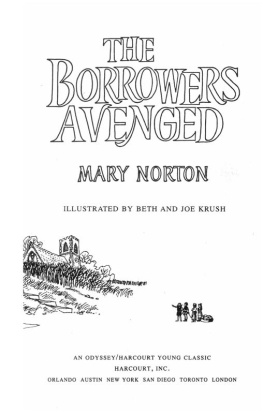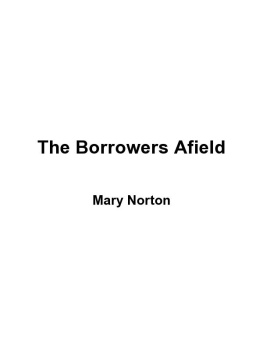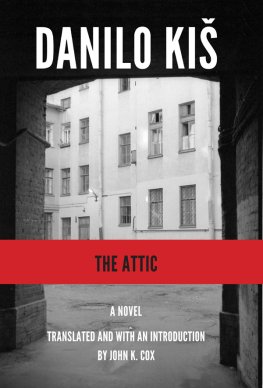

ILLUSTRATED BY BETH AND JOE KRUSH
AN ODDYSSEY/HARCOURT YOUNG CLASSIC
HARCOURT, INC.
ORLANDO AUSTIN NEW YORK SAN DIEGO TORONTO LONDON
The Borrowers Aloft
Text copyright 1961 by Mary Norton
Copyright renewed 1989 by Maty Norton
Illustrations copyright 1961 by Beth Krush and Joe Krush
Copyright renewed 1989 by Beth Krush and Joe Krush
Poor Stainless
Text copyright 1971 by Mary Norton
Illustrations copyright 1971 by Beth Krush and Joe Krush
All rights reserved. No part of this publication may be reproduced
or transmitted in any form or by any means, electronic or mechanical,
including photocopy, recording, or any information storage and retrieval
system, without permission in writing from the publisher.
Requests for permission to make copies of any part of the work should be
mailed to the following address: Permissions Department, Harcourt, Inc.,
6277 Sea Harbor Drive, Orlando, Florida 32887-6777.
www.HarcourtBooks.com
First Harcourt Young Classics edition 1998
First Odyssey Classics edition 1990
The Borrowers Aloft first published 1961
Poor Stainless first published 1966
Library of Congress Cataloging-in-Publication Data
Norton, Mary.
[Borrowers aloft]
The borrowers aloft; with the short tale Poor Stainless/Mary Norton;
illustrated by Beth and Joe Krush.
p. cm.
"An Odyssey/Harcourt Young Classic."
Summary: Two stories about a family of tiny people called the Borrowers, in which the
family is kidnapped, and the youngest boy is discovered missing.
1. Children's stories, English. [1. Fantasy. 2. Short stories.]
I. Krush, Beth, ill. II. Krush, Joe, ill. III. Norton, Mary. Poor Stainless. 1998.
IV. Title. V. Title: Poor Stainless.
PZ7.N8248Blb 1998 [Fic]dc21 97-43173
ISBN 0-15-210524-7 ISBN 0-15-204734-4 (pb)
Printed in the United States of America
T V X Y W U S
E G H F D B (pb)
This story is dedicated with love to Tom Brunsdon and Frances Rush and to all the children in the world who have promised their parents never to play with gas and who keep their promises
Chapter One
Some people thought it strange that there should be two model villages, one so close to the other. (There was another, as a matter of fact, which nobody visited and which we need not bother about because it was not built to last.)
One model village was at Fordham, called Little Fordham: it belonged to Mr. Pott. Another was at Went-le-Craye, called Ballyhoggin, and belonged to Mr. Platter. The third (which nobody knew about) was at Quilter's End and made with shoe boxes: it belonged to a little girl called Agnes Mercy Foster, and it did not have a name.
It was Mr. Pott who started it all, quietly and happily for his own amusement; and it was the businesslike Mr. Platter, for quite another reason, who copied Mr. Pott.
Mr. Pott was a railway man who had lost his leg on the railway: he lost it at dusk one evening on a lonely stretch of linenot through carelessnessbut by saving the life of a badger. Mr. Pott had always been anxious about these creatures: the single track ran through a wood, and in the half-light, the badgers would trundle out, sniffing their way across the ties. Only at certain times of the year were they in any real danger, and that was when the early dusk (the time they liked to sally forth) coincided with the passing of the last train from Hatter's Cross. After the train passed, the night would be quiet again; and foxes, hares, and rabbits could cross the line with safety; and nightingales would sing in the wood.
In those early days of the railway, Mr. Pott's small, lonely signal box was almost a home-from-home. He had there his kettle, his oil lamps, his plush-covered table, and his broken-springed railway armchair. To while away the long hours between trains, he had his fret saw, his stamp collection, and a well-thumbed copy of the Bible, which sometimes he would read aloud. Mr. Pott was a good man, very kind and gentle. He loved his fellow creatures almost as much as he loved his trains. With the fret saw he would make collecting boxes for the Railway Benevolent Fund; these were shaped like little houses, and he made them from old cigar boxes, and none of, his houses was alike. On the first Sunday of every month, Mr. Pott, on his bicycle, would make a tour of the village, armed with a screw driver and a small black bag. At each home or hostelry, he would unscrew the roof of a little house and count out the contents into his bag. Sometimes he was cheated (but not often) and would mutter sadly as he rode away"Fox been at the eggs again."

Occasionally, in his signal box, Mr. Pott would paint a picture, very small and detailed. He had painted two of the church, three of the vicarage, two of the post office, three of the forge, and one of his own signal box. These pictures he would give away as prizes to those who collected most for his fund.
But, on the night of which we speak, the badger bit Mr. Pottthat was the trouble. It made him lose his balance, and in that moment's delay, the train wheels caught his foot. Mr. Pott never saw the marks of the badger's teeth because the leg it bit was the leg they cut off. The badger itself escaped unharmed.
The Railway Benevolent were very generous. They gave Mr. Pott a small lump sum and found him a cottage just outside the village, where three tall poplar trees stood beside a stream. It was here, on a mound in his garden, that he started his model railway.
First, he bought at second hand a set of model trains. He saw them advertised in a local paper with the electric battery on which to run them. Because there was no room large enough in his tiny cottage, he set up the lines in his garden. With the help of the blacksmith, he made the rails, but he needed no help with the ties; these he cut to scale and set them firmly, as of old he had set the big ones. Once these were set, he tarred them over, and when the sun was hot, they smelled just right. Mr. Pott would sit on the hard ground, his wooden leg stretched out before him, and close his eyes and sniff the railway smell. Lovely it was, and magicbut something was missing. Smoke, that's what it was! Yes, he badly needed some smokenot only the tang of it, but the sight of it as well. Later, with the help of Miss Menzies of High Beech, he found a solution.
The next stage occurred to him on his walks to and from the blacksmith when he would pass the shoe-box village of Agnes Mercy Foster. He would watch its gradual construction through a thin place in the hedge. He did not interrupt hershe seemed too intent and happy, kneeling in her pinafore among the weeds and grasses, with the soles of her black boots turned up toward him. Sometimes she was painting doors and windows, and sometimes she was thatching the roofs with moss. One day, she had made a pond. He was sad for her when the rain came. Steadily and mercilessly, it streamed down. The warm ground smoked, and the shoe-box houses became soggy and began to fall apart. He would see, through the gray mist, Agnes Mercy's face staring out from behind a casement window, framed in red geraniums. "Nay, poor maid," he would mutter, shaking his head, "cardboard's no good. I could have told 'ee that. Nor plywood neither."
Next page












